Introduction

The SMART Optimus family heralds the beginning of a new era for the datacenter, the inclusion of MLC NAND SSDs into roles typically only served via SLC high-endurance SSDs.
Extracting SLC-like endurance from MLC using a variety of techniques, collectively referred to as the Guardian Technology Platform, has led SMART down the path of explosive growth. SMART Storage Systems can claim every single Tier-1 OEM as a customer and they are currently the only SSD vendor with its SSDs qualified across multiple IBM platforms. This deep entrenchment into the enterprise space speaks volumes to the quality of the products that SMART offers its customers. Endurance, performance, reliability, and value are the hallmarks that can make or break an enterprise-class SSD solution, and SMART looks to deliver with the Optimus series.
The Optimus series leverages DSP and adaptive flash programming at the core of its controller, dramatically reducing errors and increasing the longevity of the underlying NAND. These new approaches to NAND management bring a compelling enterprise-class storage solution within reach of consumer price points.
In the past, datacenters and enterprise applications consisting of heavy write workloads have been constrained to deploying expensive SLC solutions. These SLC SSDs can come at a hefty premium of up to $11 a gigabyte. Recently eMLC has begun to make a splash, offering higher write endurance in tandem with more palatable pricing.
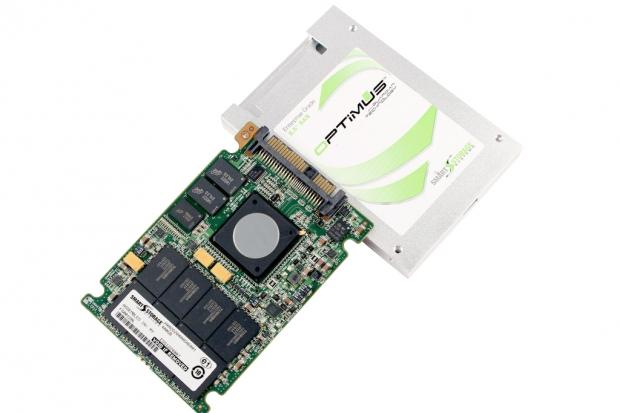
Rapid advancements in flash management technology have brought garden-variety MLC into the datacenter, providing enough endurance for light enterprise workloads. Low cost is the primary motivator for users to make the jump to MLC, but SMART's goal is the transformation of this same low-endurance MLC into a direct competitor with SLC products while also preserving the lower cost structure of MLC products. The Optimus offers an amazing 10 DWPD (drive writes per day) for a five year warrantied period.
Sporting high performance in tandem with impressive endurance in capacities of 200GB, 400GB, 800GB and 1.6TB provides customers with a wide range of available capacity options. Read speeds weigh in at 100K IOPS and 500MB/s of sustained sequential transfer. The write speed is also impressive, with 50K IOPS and 500MB/s of sequential write speed. Perhaps most impressive is the capability of the SSD to offer up 1GB/s of sustained read performance in applications that support dual-port 6Gb/s SAS functionality.
SMART designs its SSDs to operate within 1% performance variability over the life of the SSD to guarantee consistency of service. Adaptive flash programing and DSP (Digital Signal processing) are emerging technologies that provide increased endurance. STEC, with their CellCare products, and Anobit are SMART's most notable competitors utilizing similar technologies. Apple snapped up Anobit earlier this year, effectively removing them from the picture. This leaves STEC and SMART's high performance and endurance MLC SSDs to compete directly with each other.
Guardian Technology Platform
Before assembly, SMART subjects all NAND to an extensive re-characterization, which reassigns more accurate P/E Ratios to the NAND. Aggregated flash management ensures that there is an even distribution of different classes of NAND present on each SSD to benefit the whole. Once assembled the Guardian Technology Platform takes over and the NAND settings are monitored and adjusted constantly. This keeps the NAND perfectly in tune over the life of the SSD.
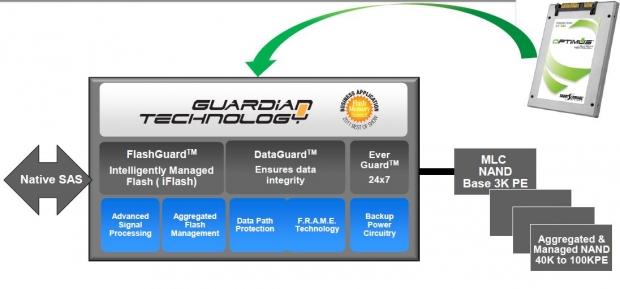
The award-winning Guardian Technology Platform is SMART's proprietary approach consisting of three integral components.
FlashGuard
As NAND geometries shrink, the endurance of the NAND also shrinks and the data errors multiply. This creates major difficulties that have hampered the introduction of low endurance MLC NAND into the datacenter. Data errors are typically solved with ECC (Error Correction Code). This can reach a diminishing point of returns when more powerful ECC algorithms create excessive overhead, leading to performance degradation and higher latency. SMART utilizes DSP (Digital Signal Processing) in concert with advanced ECC algorithms to combat these data errors.
NAND is typically programmed for retention and wear metrics during NAND processing and the settings are never altered. Adaptive programming dynamically adjusts flash parameters over the course of the SSDs life, tailoring the NAND settings at the base level. This creates exponential increases in endurance of the underlying NAND. Typical SSDs can only achieve wear leveling on each NAND package. Aggregated Flash Processing treats all of the flash elements as a whole and provides global cross-die wear leveling.
DataGuard
DataGuard provides full data path protection (T-10 DIF compliant) and the F.R.A.M.E. (Flexible Redundant Array of Memory Elements) functionality. F.R.A.M.E. is a cross-die data redundancy feature, similar to parity, which allows for data reconstruction in the event of a catastrophic event, such as a flash page or even an entire NAND block failure.
EverGuard
EverGuard is a third generation host power-loss protection approach that protects against unexpected power interruptions. An array of highly reliable discrete Tantalum capacitors provides the power to flush all data in transit to the NAND during loss of power. These Tantalum capacitors are rated for high temperature environments and do not experience degradation over time.
There are additional architectural features that reduce the power hold up time requirements, with advanced controller power management, and lower pages reserved for power-down writes. The power is rated at 7W (Typical) when active, with VCC 5V, -5%/+10%.
These features are rounded out with AES 256-bit encryption, TCG Enterprise Compliant security and a five year warranty.
SMART Optimus Internals
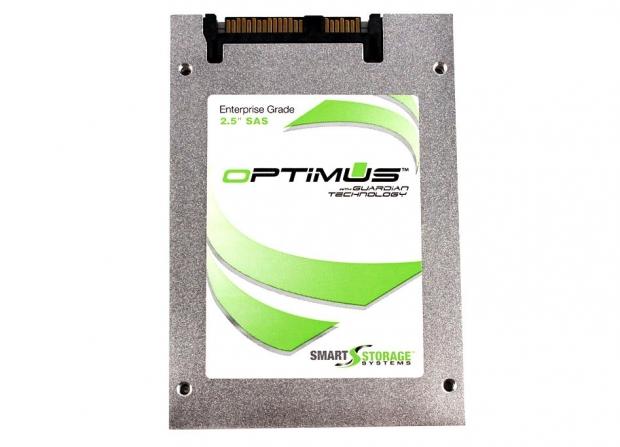
The SMART Optimus comes in a machined alloy chassis that has quite a bit of heft to it. It sports a 9.5mm Z-height, though the 1.6TB version is a 15mm product.
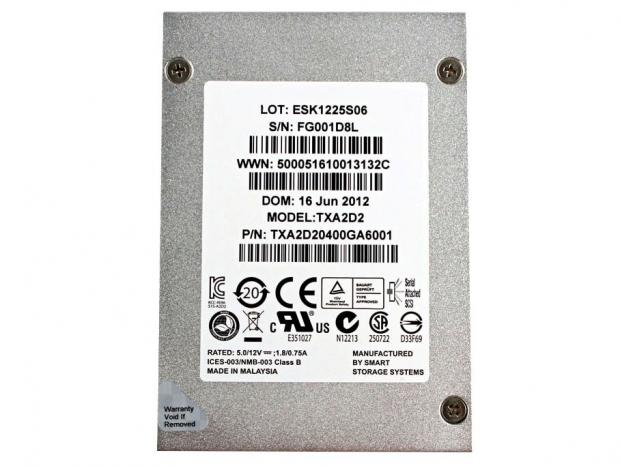
The bottom of the SSD holds the relevant product numbers and model information.
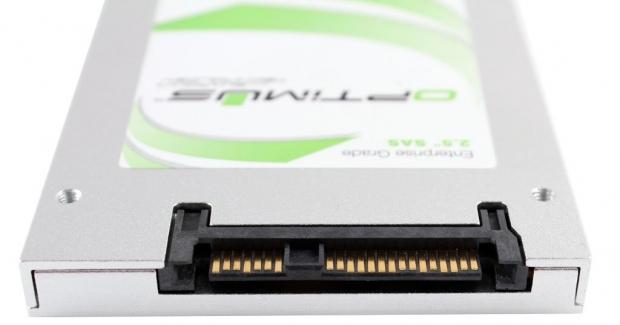
The dual-port 6Gb/s SAS connection provides the enterprise class features that SATA SSDs simply cannot. A robust dual-port SAS 6Gb/s connection allows Multipath I/O for either failover (High -Availability) or performance scaling. SAS provides lower latency in heavy workload environments via a higher allowable Queue Depth of 256, while SATA can only support 32.
SATA connections transfer data at half-duplex, meaning that they cannot read and write simultaneously. SAS features full duplex data transfers, reading and writing simultaneously through each port. SAS also supports the SCSI command set, which allows users a much more flexible and capable interface than SATA. Finally, SAS allows for longer cabling, up to 8m long, compared to only 1m with SATA devices.
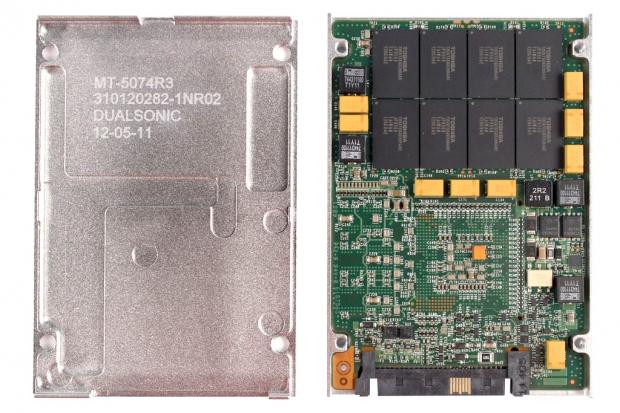
Upon removal of the top of the case, we observe that the PCB is nestled tightly inside the case with no internal fasteners. This is due to the high tolerance construction of the case, which we will cover more on the following page.
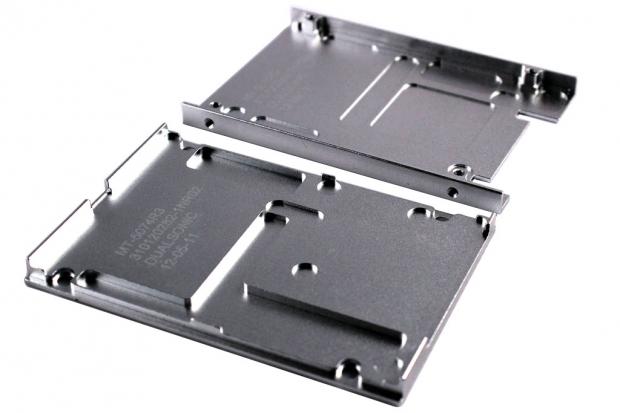
The alloy casing is machined to a very close tolerance, with milled channels that fit the protruding components of the PCB. This very close tolerance milling creates a gap between the components and the casing. The very small amount of space between the components and the casing facilitates heat transfer from the components to the case of the SSD. This approach forgoes the usage of thermal pads, yet provides the same excellent thermal transfer characteristics.
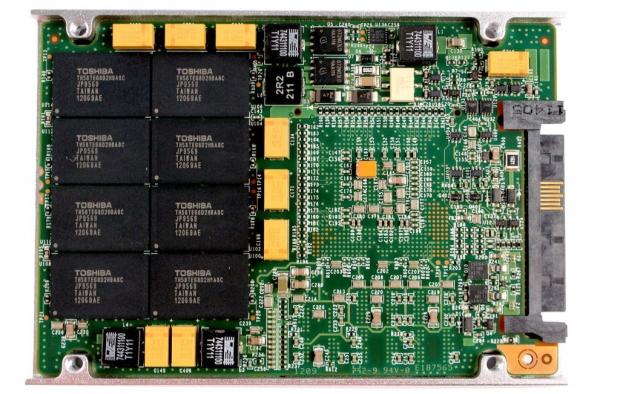
The yellow blocks are the Tantalum capacitors that provide power hold-up during host power-loss events. Supplying power to the controller and NAND during power loss allows the SSD to write all data contained in buffers or cache down to the NAND.
The Toshiba MLC Toggle NAND (TH58TEG8D2HBA8C) comes in 16 packages of 32GB. There is an included 28% assigned for the SSDs use, including F.R.A.M.E. and overprovisioning.
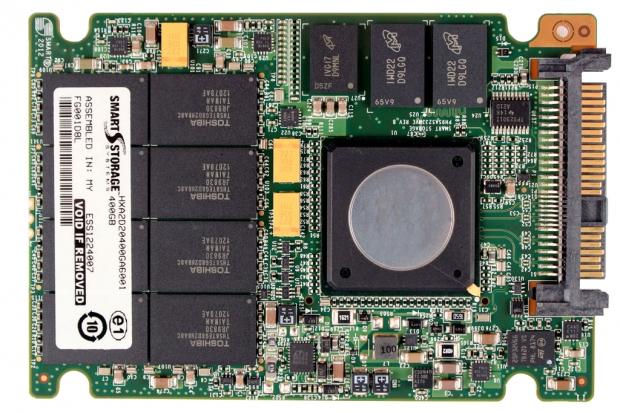
The SMART controller is part of the Guardian Technology Platform. This firmware and controller combination controls the NAND and settings using adaptive NAND management techniques. The DRAM caching modules are also included on this side of the PCB - Micron IC's total 640MB.
Test System and Methodology

We utilize a new approach to HDD and SSD storage testing here at TweakTown for our Enterprise Test Bench. Comparisons to other SSDs will be forthcoming as we test new models and SSDs from various manufacturers.
Designed specifically to target the long-term performance of solid state with a high level of granularity, our new SSD testing regimen is applicable to a wide variety of flash devices. From typical form-factor SSDs to the hottest PCIe application accelerators available, we are utilizing this new test regimen to provide accurate performance measurements over a variety of parameters.
Many forms of testing involve utilizing peak and average measurements over a given time period. While these average values can give a basic understanding of the performance of the storage solution, they fall short in providing the clearest view possible of the QOS (Quality Of Service) of the I/O.
The problem with average results is that they do little to indicate the variability experienced during the actual deployment of the device. The degree of variability is especially pertinent, as many applications can hang or lag as they wait for one I/O to complete. This type of testing illustrates the performance variability expected in these types of scenarios while also including a whole host of other relevant data, including the average measurements during the measurement window.
In reality, while under load all storage solutions deliver variable levels of performance that are subject to constant change. While this fluctuation is normal, the degree of fluctuation is what separates enterprise storage solutions from typical client-side hardware. By providing ongoing measurements from our workloads with one-second reporting intervals, we can illustrate the difference between different products in relation to the purity of the QOS while the device is under load. By utilizing scatter charts readers can get a basic understanding of the latency distribution of the I/O stream without directly observing numerous graphs.
Consistent latency is the goal of every storage solution, and measurements such as Maximum Latency only illuminate the single longest I/O received during testing. This can be misleading, as a single 'outlying I/O' can skew the view of an otherwise superb solution. Standard Deviation measurements take the average distribution of the I/O into consideration, but do not always effectively illustrate the entire I/O distribution with enough granularity to provide a clear picture of system performance. We use histograms to illuminate the latency of every single I/O issued during our test runs, providing a clear picture of the actual percentage of I/O requests that fall within each latency range.
Our testing regimen follows SNIA principles to ensure consistent, repeatable testing. Due to the very nature of NAND devices, it is important that we test under steady state conditions. We attain steady state convergence through a process that brings the device within a performance level that does not range more than 20% from the average speed measured during the measurement window.
We only test below QD32 to illustrate the scaling of the device. However, low QD testing with enterprise-class storage solutions is a frivolous activity if not presented with higher QD results as well. Administrators that have optimized their infrastructure correctly sustain high QD levels, capitalizing on the performance of the premium tier of storage that SSDs provide. With the explosion of virtualization into the datacenter, the high QD performance of the storage solution is the most important metric.
The first page of results will provide the 'key' to understanding and interpreting our new test methodology.
4K Random Read/Write
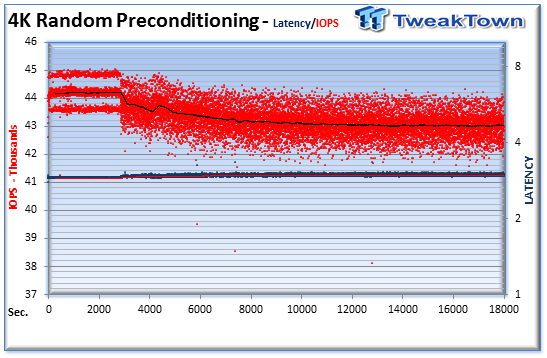
We preconditioned the SMART Optimus with a heavy 4K random write workload for 18,000 seconds, or five hours. Every second we are receiving reports on several parameters of the workload performance. We then plot this data to illustrate the drives' descent into steady state.
This chart consists of 36,000 data points. The red dots signify the IOPS during the test, and the blue dots are the latency encountered during the test period. We place the latency data in a logarithmic scale to bring it into comparison range. This is a dual-axis chart with the IOPS on the left and the latency on the right. The lines through the data scatter are a moving average during the test. This type of testing presents standard deviation and maximum I/O in a visual manner.
Note that the IOPS and Latency figures are nearly mirror images of each other. This illustrates the point that the scatter testing can give our readers a good feel for the latency distribution by viewing the IOPS at one-second intervals. This should be in mind when viewing our read and write results below.
We provide histograms to provide further latency granularity below. This preconditioning slope of performance happens very few times in the lifetime of the device, and we present these test results only to confirm the attainment of steady state convergence.
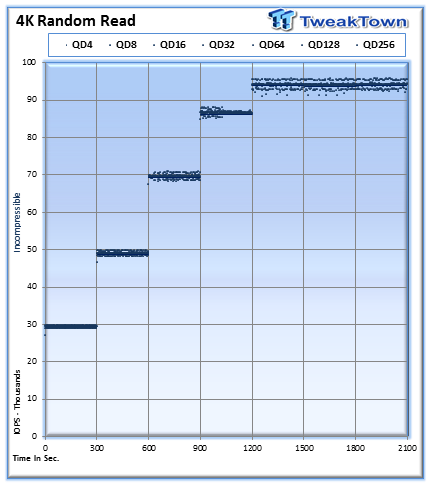
Each QD for each parameter tested includes 300 data points (five minutes of one second reports) to illustrate the degree of performance variability. The line for each QD represents the average speed reported during the five-minute interval.
4K random speed measurements are an important metric when comparing drive performance, as the hardest type of file access for any storage solution to master is small-file random. One of the most sought-after performance specifications, 4K random performance is a heavily marketed figure.
The SMART Optimus 4K random read speed tops out at 95,250 IOPS at QD256.
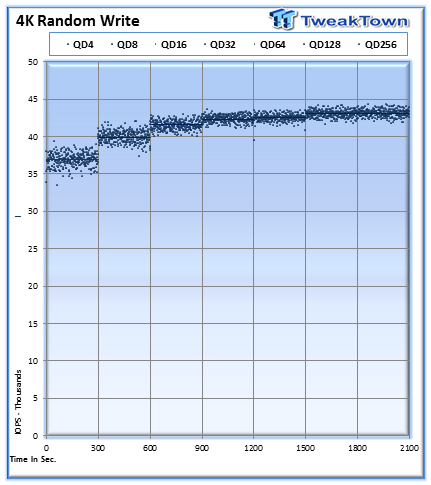
The 4k random write speeds top out at 43,936 IOPS at QD256, with very solid consistency. There is very little variability in the write speed results; especially in the high QD range, the I/O stream is remarkably consistent.
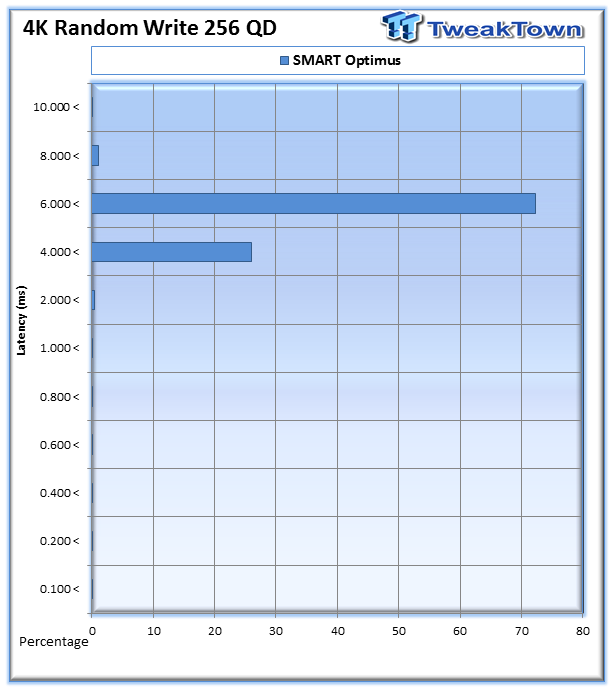
The histogram represents the latency of every single I/O during the QD256 testing period represented in percentages. During testing the majority of 4K writes, 73% (9,514,589 I/O's), fell in the 6-8ms range. 24% of requests (3,133,340 I/O's) fell into the 4-6ms range.
8K Random Read/Write
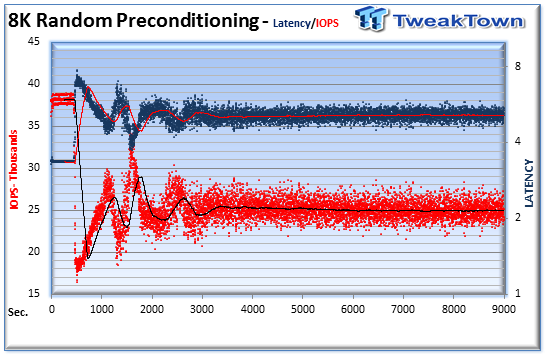
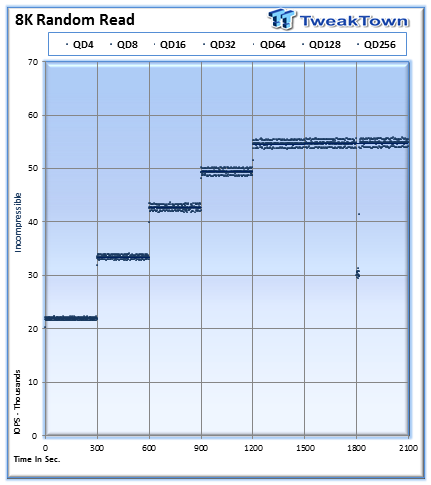
8K random read and write speed is a metric that is not tested for consumer use, but for enterprise environments this is an important aspect of performance. With several different workloads relying heavily upon 8K performance, we include this as a standard with each evaluation. Many of our Server Emulations below will also test 8K performance with various mixed read/write workloads.
The 8K random read results are consistent, averaging 54,767 IOPS at QD256.
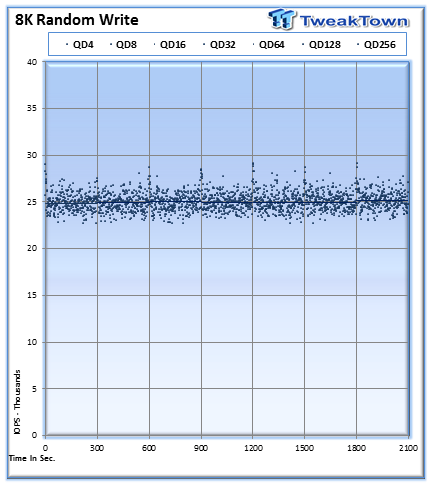
The 8K random write speed averages 25,096 IOPS at QD256. The highest speed recorded was 27,639 IOPS and the lowest was 23,175 IOPS at QD256.
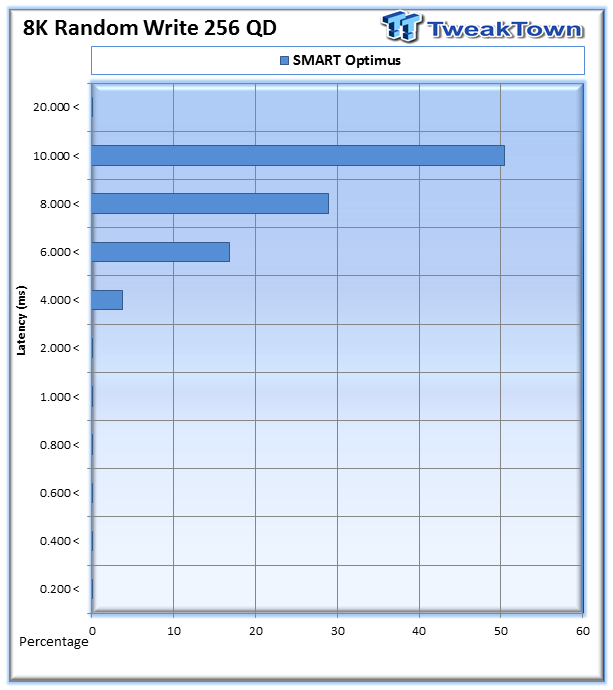
50% (3,749,620 I/O's) of the 8K writes at QD256 fell into the 10-20ms range, and 28% (2,177,638 I/O's) fell into the 8-10ms range.
128K Sequential Read/Write
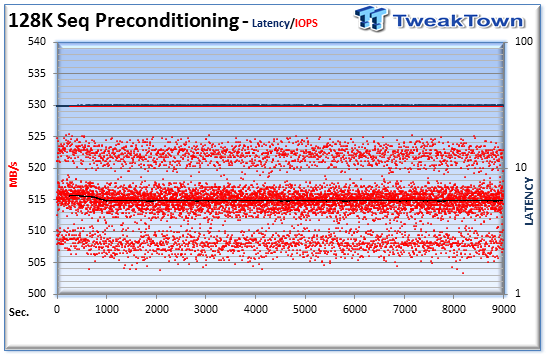
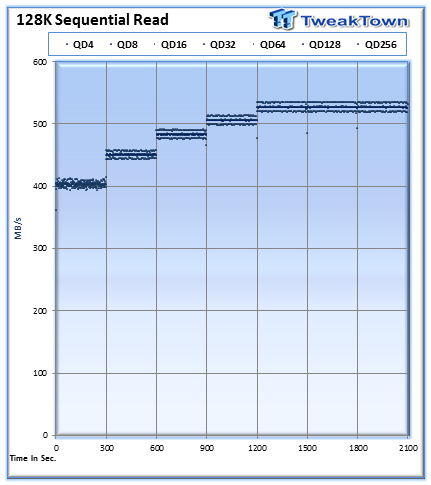
The 128K sequential read speeds reflect the maximum sequential throughput of the SSD using a realistic file size actually encountered in an enterprise scenario.
The SMART Optimus can deliver dual port performance of 1GB/s in sequential read speed with applications that support the functionality. We tested in single port mode, and reached an average of 526MB/s in sequential read transfer at QD256.
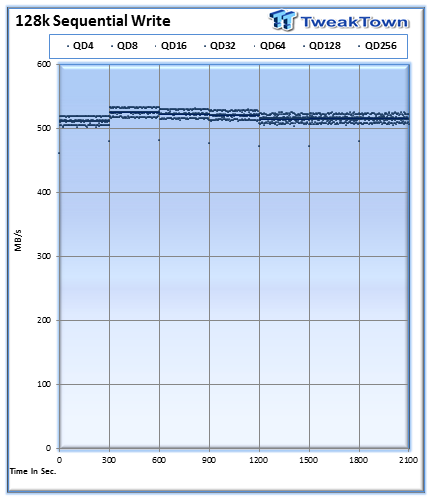
The Optimus provides 514MB/s of sequential write speed at QD256. There is very little variability in the results, with strong consistent performance across the board.
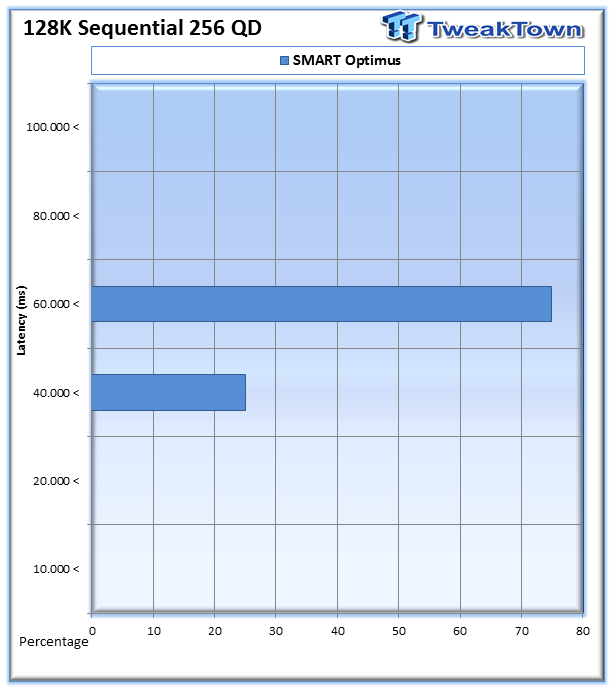
74% (923,304 I/O's) of write requests fell into the 60-80ms range, and 25% (308,225 I/O's) fell into the 60-80ms range.
OLTP and Webserver
OLTP
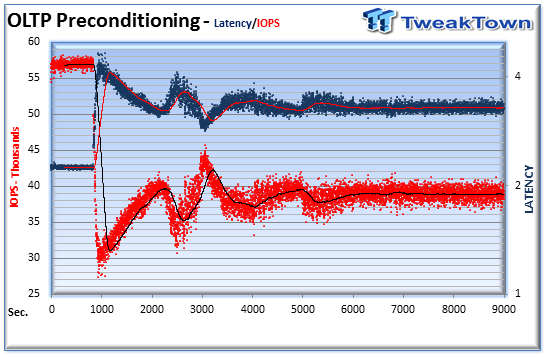
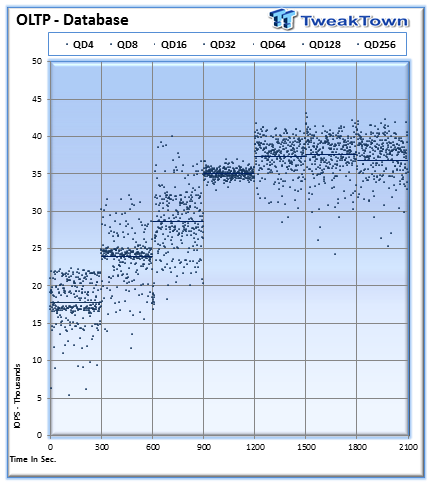
This test emulates Database and On-Line Transaction Processing (OLTP) workloads. OLTP is in essence the processing of transactions such as credit cards used heavily in the financial sector. Enterprise SSDs are uniquely well suited for the financial sector with low latency and high random workload performance. Databases are the bread and butter of many enterprise deployments. These are demanding workloads with 8K random of 66% read and 33% write distribution that can bring even the highest performing solutions down to earth.
At QD256 Optimus averages 36,837 IOPS, with fast IOPS reaching into the 42,000 range and the low end down to 25,000 IOPS.
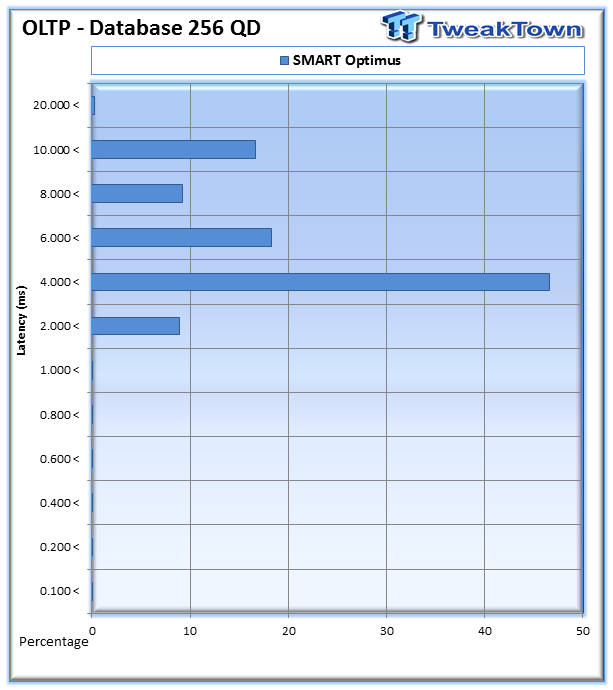
There was a wide range of latency results at QD256, with 46% (5,213,758 I/O's) falling into the 4-6ms range. 18% (2,039,965 I/O's) fell into the 6-8ms range.
Webserver
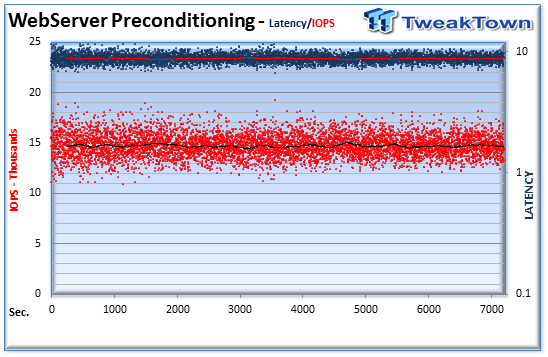
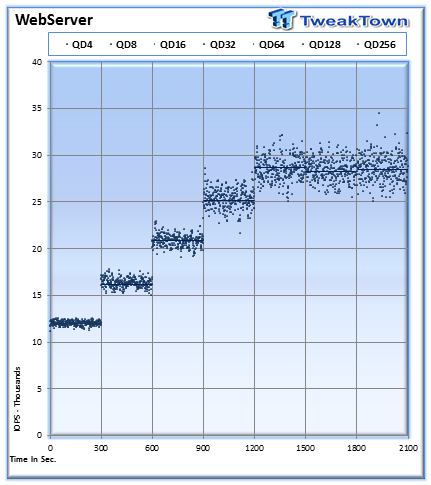
The Webserver profile is a read-only test with a wide range of file sizes. Web servers are responsible for generating content for users to view over the internet, much like the very page you are reading. The speed of the underlying storage system has a massive impact on the speed and responsiveness of the server that is hosting the websites and thus the end user experience.
This read only test really highlights the agility of the SMART Optimus, averaging 28,468 IOPS in this demanding test. The highest recorded speed was 34,409 IOPS and the lowest was 25,500 IOPS at Q256.
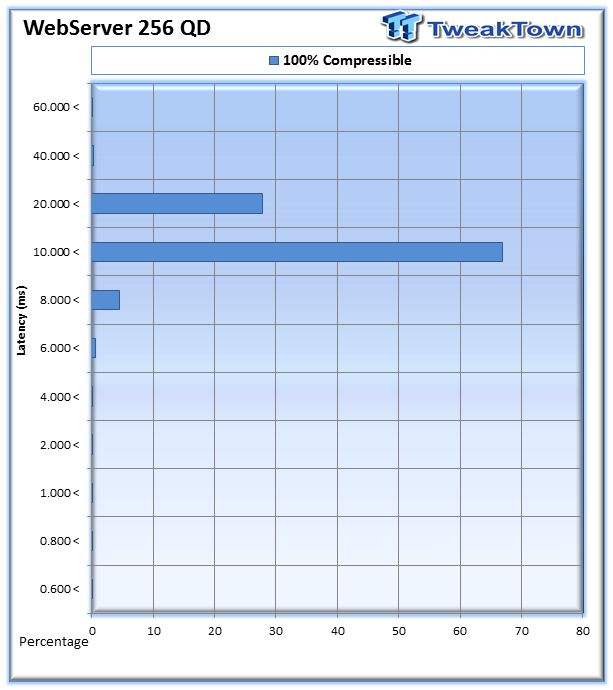
66% (2,930,679 I/O's) fell into the 10-20ms range. 27% (1,214,919 I/O's) fell into the 20-40ms range.
Fileserver, Workstation, and Emailserver
Fileserver
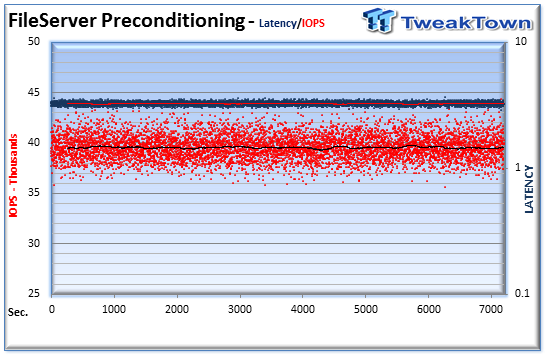
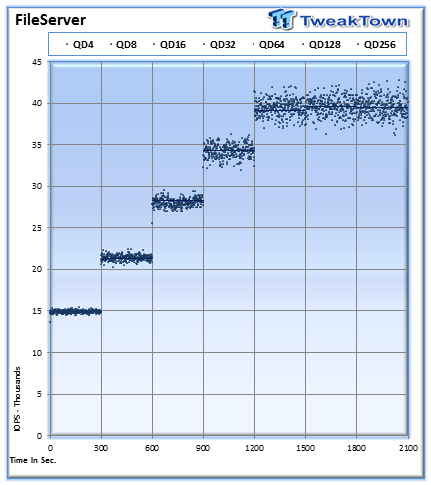
The File Server profile represents typical workloads encountered in file servers. This profile tests across a wide variety of different file sizes simultaneously, with an 80% read and 20% write distribution.
At QD256 the Optimus averaged 39,434 IOPS.
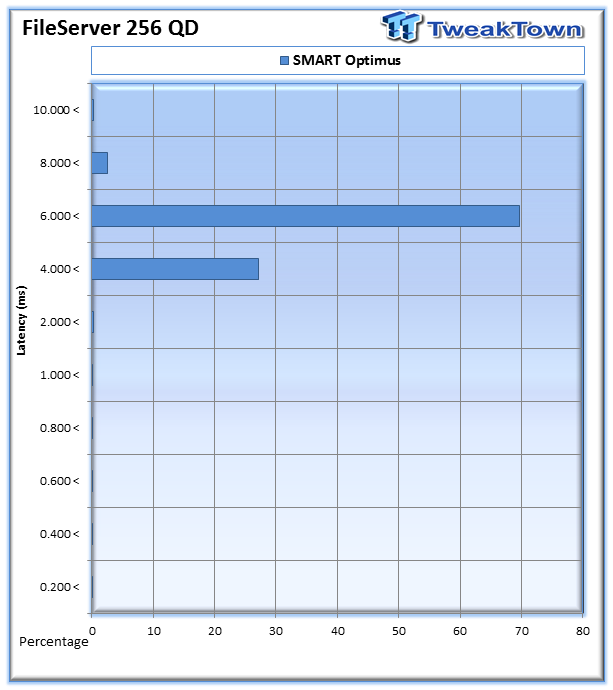
69.7% (8,240,543 I/O's) of IOPS fell into the 6-8ms range, and 27% of IOPS (3,202,035) fell into the 4-6ms measurement range.
Workstation
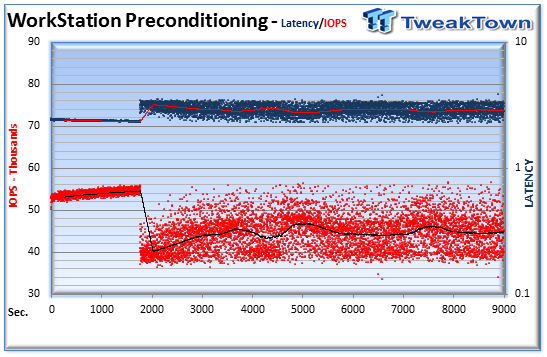
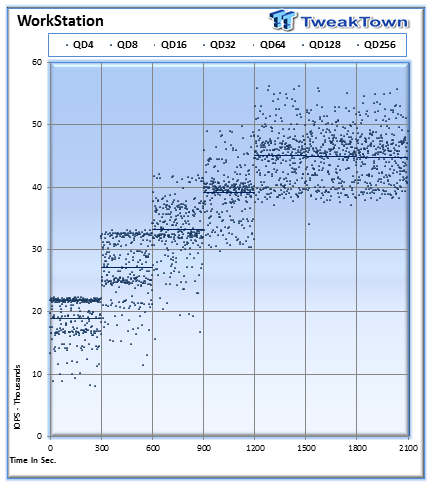
The Workstation profile is indicative of the type of file access requested by a high performance workstation. The workload consists of 8k access with an 80% read and 20% write distribution.
The SSD averaged 44,740 IOPS over the duration of the QD256 testing. The lowest recorded speed was 38,248 IOPS, and the highest was 55,457 IOPS.
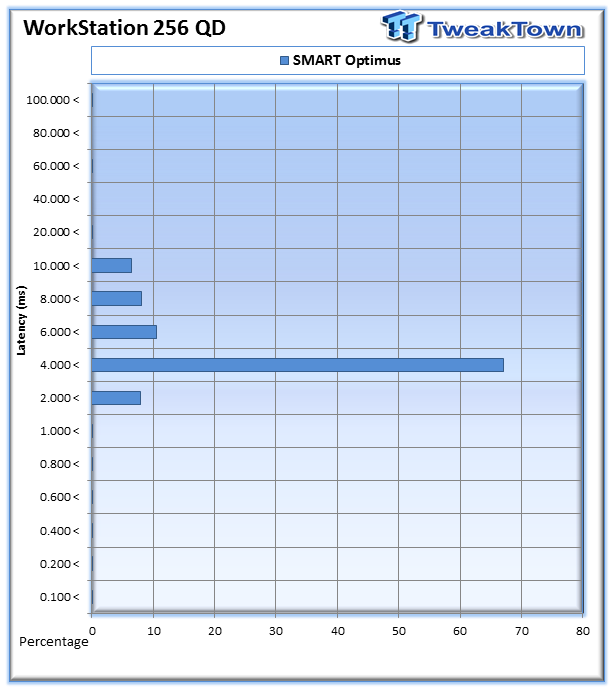
67% (9,022,634 I/O's) were recorded in the 4-6ms range, with a smattering of results above and below this measurement.
Emailserver
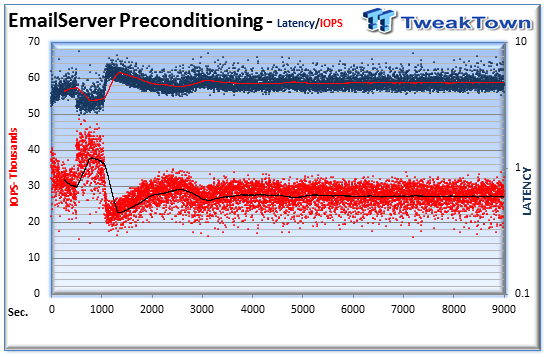
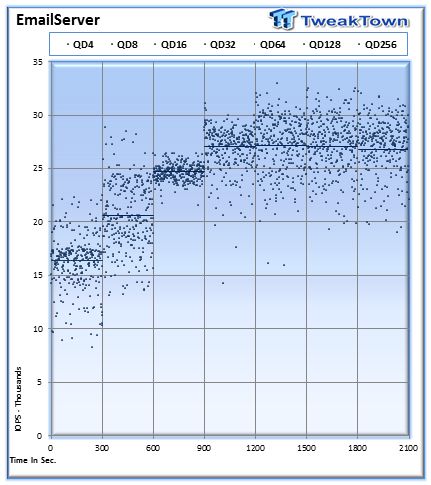
The Emailserver profile is very demanding 8K test with a 50% read and 50% write distribution. This application is indicative of the performance of the solution in heavy write workloads. The Optimus averages 26,762 IOPS in the QD256 testing. There is a wide variability in the speed, with the lowest falling at 18,980 IOPS and the highest coming in at 32,184 IOPS.
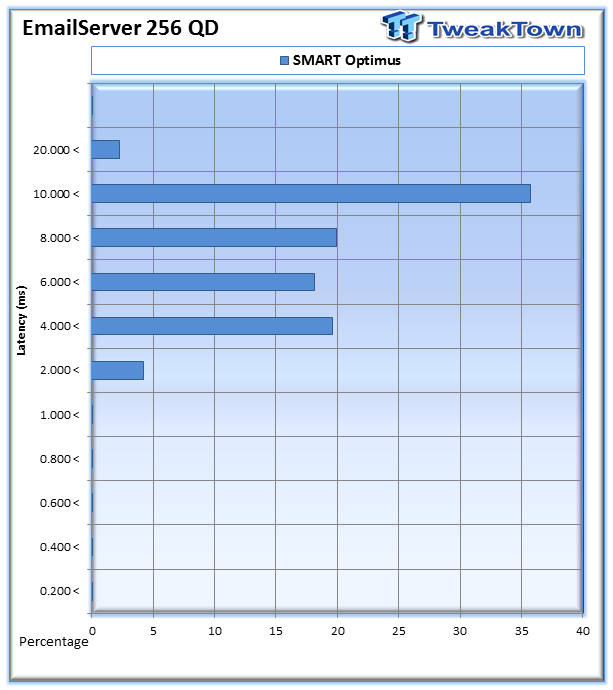
35.7% (2,903,306 I/O's) fall into the 10-20ms range, with a heavy distribution of the results following into lower latency ranges.
Final Thoughts
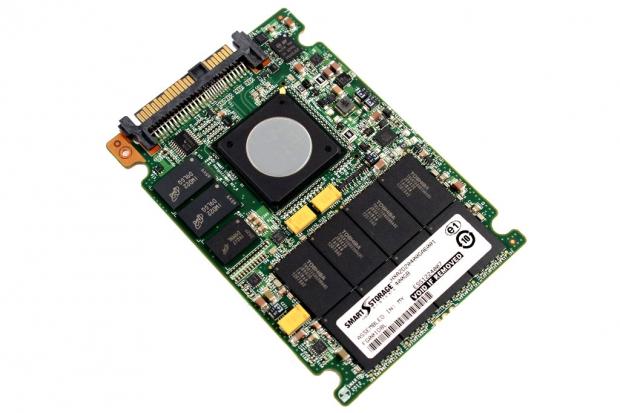
The SMART Optimus sets a standard with an approach that we expect to see much more of in the future. The future of SSD flash management is going to lean heavily towards adaptive flash interaction and DSP technologies. Dynamically learning from and adjusting the very NAND itself over the lifetime of the SSD brings unbelievable endurance from standard MLC. The exponential endurance gains from this type of technology are sure to be utilized among a wide variety of vendors as time progresses.
SMART feels like they are ahead of the game in this respect, helping to pioneer the technology has given them a great position early. Developing IP and already holding several patents in this arena serves to provide them the high ground in the high endurance MLC field.
With new higher-endurance versions of the SMART Optimus already in the pipeline, SMART is poised to deliver SLC-like endurance at close to MLC price points. The new Optimus Ultra+ is capable of a shocking 50 Drive Writes Per Day (DWPD) from simple everyday MLC NAND. This is approaching SLC endurance levels, according to our rough math this is nearly 90,000 IOPS from MLC NAND.
Providing SLC-like endurance from MLC NAND sounds like a magic trick or marketing hype at its finest. Breaking it down and looking at the various technologies that SMART has developed with the Guardian Technology Platform helps to understand the methods taken to ensure data reliability in the long run. Pairing these ultra-endurance parts with enterprise-class features and performance is important. The SMART Optimus delivers blazing speeds that are remarkably consistent in our test regimen. We observed very little variability in the course of our testing.
Dual Port SAS brings deployments into High-Availability environments into the picture, and the active-active dual port functionality provides up to 1GB/s from a single SSD. SAS also brings the advantages of the SCSI command set, which allows seamless use when pairing these SSDs with HBAs and other SCSI devices.
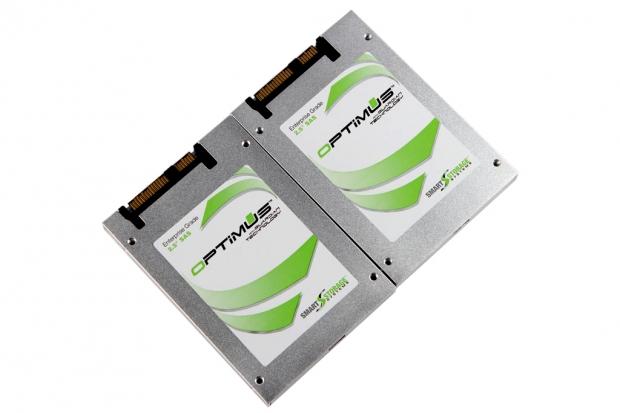
The 10 DWPD endurance offered by the Optimus is backed up with a five year warranty. Perhaps most impressive is the fact that SMART designs their SSDs to operate within 1% of performance variability over the service life of the device.
Several sales wins have brought the Optimus into the limelight. RAID, Inc. has recently integrated the Optimus into its EBOD Storage Solution touting 1 million IOPS and X-IO is integrating the SSD into the Hyper ISE 7-Series. Expect SMART to continue to develop the Optimus line extensively into the future. In concert with their extensive Tier-1 OEM customers, the Optimus should enjoy great success in the market.
With its innovative new approaches to adaptive flash management and increased endurance, we give the Optimus the TweakTown Editor's Choice Award.

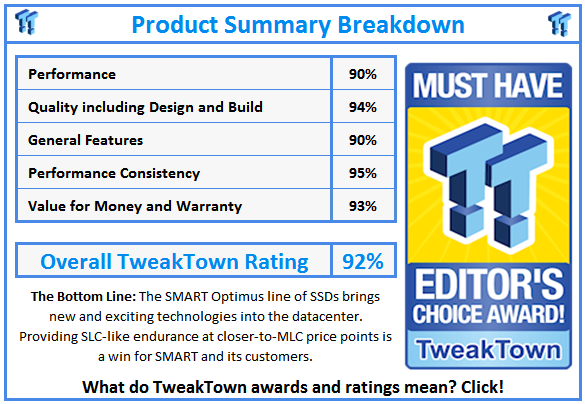
 United
States: Find other tech and computer products like this
over at
United
States: Find other tech and computer products like this
over at  United
Kingdom: Find other tech and computer products like this
over at
United
Kingdom: Find other tech and computer products like this
over at  Australia:
Find other tech and computer products like this over at
Australia:
Find other tech and computer products like this over at  Canada:
Find other tech and computer products like this over at
Canada:
Find other tech and computer products like this over at  Deutschland:
Finde andere Technik- und Computerprodukte wie dieses auf
Deutschland:
Finde andere Technik- und Computerprodukte wie dieses auf